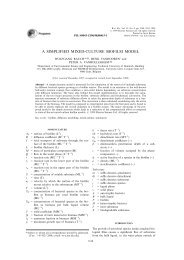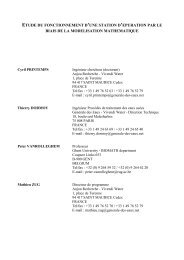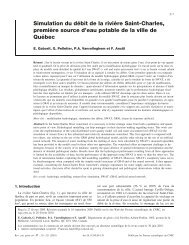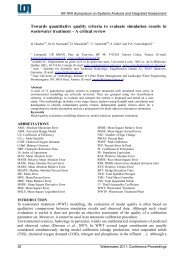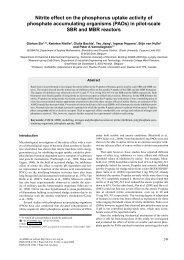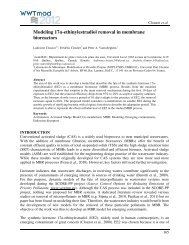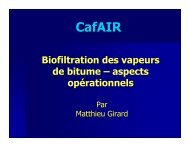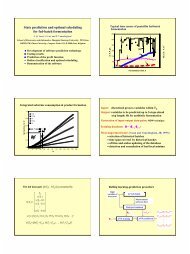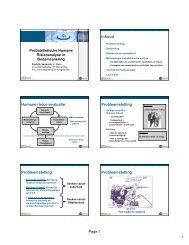Biological Phosphorus Removal Using SBR Technology :
Biological Phosphorus Removal Using SBR Technology :
Biological Phosphorus Removal Using SBR Technology :
You also want an ePaper? Increase the reach of your titles
YUMPU automatically turns print PDFs into web optimized ePapers that Google loves.
MATERIALS and METHODS<br />
The study was carried out in a laboratory fermentor (Biostat, B. Braun, Melsinger) with a maximum volume<br />
of 11 filled with 8 of mixed liquor. To achieve EBPR the reactor was operated as a <strong>SBR</strong> with a cycle length<br />
of 6 hours: filling (15 minutes) (anaerobic), anaerobic phase (1.5 hours), aerobic phase (3 hours and 15 minutes),<br />
anaerobic in-between phase (maximum 10 minutes), during which nitrogen gas is flushed through the<br />
mixed liquor to prevent remaining oxygen entering the anaerobic period of the following cycle, settling phase<br />
(minimum 33 minutes) and an effluent purge (17 minutes). At the end of the aerobic phase 200 ml of mixed<br />
liquor is removed to obtain a sludge age of 10 days. Four litres of supernatant were removed at the end of the<br />
cycle and 4 litres of medium were fed at the beginning of the cycle, yielding a hydraulic retention time of 12<br />
hours. <strong>Using</strong> lactate/acetate mixtures, the length of the aerobic phase was increased by 2 hours in order to obtain<br />
complete phosphorus removal. To promote growth of SRBs, the length of the anaerobic phase was increased<br />
to 2 hours and 45 minutes and the length of the aerobic phase was shortened to 2 hours and 15 minutes.<br />
The feed compositions and phase lengths during the different research periods are presented in Table 1.<br />
Table 1 Feed compositions and phase lengths during the different research periods<br />
Acetate<br />
[g COD/]<br />
Lactate<br />
[g COD/]<br />
Ortho-P<br />
[mg P/]<br />
Anaerobic phase<br />
length<br />
Aerobic phase<br />
length<br />
Duration<br />
[days]<br />
1 st research period 400 - 15 1h30min 3h15min 136<br />
2 nd research period 800 - 15 1h30min 3h15min 22<br />
3 rd research period 800 - 45 1h30min 3h15min 10<br />
4 th research period* 800 - 45 1h30min 5h15min 4<br />
5 th research period 400 400 45 1h30min 5h15min 24<br />
6 th research period 400 400 15 2h45min 2h15min 116<br />
7 th research period 400 - 15 1h30min 3h15min …..<br />
* All other nutrients were doubled in concentration<br />
The unit was sampled twice a week to verify the phosphorus removal capacity. For this purpose, samples<br />
were taken at least at the end of the previous cycle in the settling phase, at the end of the feeding phase, at the<br />
end of the anaerobic phase and at the end of the aerobic phase. All samples were then analysed at least for<br />
ortho-P, nitrate and MLSS. COD, PHA and sulphate were analysed less frequently. When experiments were<br />
performed to elucidate the kinetics of the different reactions, at least 30 samples were taken during the anaerobic<br />
and aerobic phase of one cycle. Samples were then analysed for ortho-P, COD, nitrate, sulphate and<br />
PHA.<br />
RESULTS and DISCUSSION<br />
The <strong>SBR</strong> was initially operated to enhance biological phosphorus removal with acetate as the sole carbon<br />
source (400 mg COD/) and 15 mg P/ ortho-phosphate. The initial cycle lengths, i.e. an anaerobic phase of 1<br />
hour and 30 minutes and an aerobic phase of 3 hours and 15 minutes, were used for low acetate concentration.<br />
It was observed that full phosphorus removal could still be achieved using a higher acetate concentration, only<br />
by increasing the length of the aerobic phase with 2 hours. No acetate breakthrough to the aerobic phase occurred.<br />
Higher phosphorus and PHA concentrations were reached at the end of the anaerobic phase compared<br />
to the first research period.<br />
Table 1 Ortho-P release to COD uptake ratios, PHA formation to COD uptake and PHV to PHB ratios<br />
Period<br />
No of<br />
days<br />
elapsed<br />
Carbon source<br />
in feed<br />
[mg COD/]<br />
Ortho-P<br />
in feed<br />
[mg P/]<br />
Ortho-P release<br />
to COD uptake<br />
[mg P/mg COD]<br />
(PHB+PHV) formation<br />
to COD uptake<br />
[mg PHA/mg COD]<br />
PHV/PHB<br />
ratio<br />
[-]<br />
P-removal<br />
ratio<br />
[%]<br />
1 st 36 547 (acetate) 12.998 0.142 0.334 + 0.063 = 0.397 0.188 100<br />
1 st 43 319 (acetate) 12.880 0.209 0.365 + 0.089 = 0.454 0.244 84<br />
1 st 80 220 (acetate) 12.760 0.665 1.020 + 0.304 = 1.324 0.298 64<br />
2 nd 18 573 (acetate) 13.371 0.744 2.463 + 0.868 = 3.331* 0.353 100<br />
3 rd 5 751 (acetate) 39.581 0.404 0.771 + 0.241 = 1.012 0.312 72<br />
4 th 1 851 (acetate) 42.251 0.376 0.837 + 0.236 = 1.073 0.282 100<br />
5 th 16 lactate/acetate 38.50 n.m. n.m. 1.019 47<br />
6 th 14 785 lactate/acetate 10.07 0.209 n.m. 1.17 100<br />
6 th 15 lactate/acetate low (~ 15) n.m. n.m. 0.990 0<br />
* See further, this value is too high. Most probably the COD measurement was not correct. n.m.: not measured



